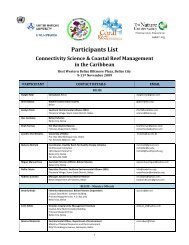The Global Water Crisis: Addressing an Urgent Security - Unu-inweh ...
The Global Water Crisis: Addressing an Urgent Security - Unu-inweh ...
The Global Water Crisis: Addressing an Urgent Security - Unu-inweh ...
Create successful ePaper yourself
Turn your PDF publications into a flip-book with our unique Google optimized e-Paper software.
Table 2. <strong>Water</strong>-related diseases (adapted from Lvovsky, 2001; P<strong>an</strong>gare et al., 2006; <strong>an</strong>d Prüss-Üstün et al., 2008).<br />
Disease<br />
category<br />
Diarrheal<br />
diseases<br />
Vector-borne<br />
diseases<br />
Diseases Disease type Tr<strong>an</strong>smission<br />
Diarrhea, cholera,<br />
dysentery,<br />
typhoid,<br />
amoebiasis,<br />
giardiasis,<br />
rotavirus<br />
gastroenteritis<br />
Lymphatic<br />
filariasis, malaria<br />
Dengue, Jap<strong>an</strong>ese<br />
encephalitis,<br />
yellow fever<br />
Gastrointestinal<br />
infection<br />
Schistomiasis Parasitic<br />
infection<br />
Blindness Onchocerciasis Nematode<br />
infection<br />
Trachoma Bacterial<br />
infection<br />
Cut<strong>an</strong>eous<br />
diseases<br />
Dracunculiasis Nematode<br />
infection<br />
Scabies Parasitic<br />
infection<br />
Paralysis Poliomyelitis Viral infection of<br />
the central<br />
nervous system<br />
Faecal-oral route; drinking water contaminated<br />
with faecal matter<br />
Parasitic<br />
Borne by black flies <strong>an</strong>d mosquitoes which breed<br />
infection in stagn<strong>an</strong>t water<br />
Viral infection Borne by black flies <strong>an</strong>d mosquitoes which breed<br />
in stagn<strong>an</strong>t water<br />
Borne by aquatic snails<br />
Borne by black files<br />
Person-to-person contact; water deficits result in<br />
poor personal hygiene <strong>an</strong>d increased risk of<br />
tr<strong>an</strong>smission<br />
Drinking water contaminated with nematodes<br />
Person-to-person contact; water deficits result in<br />
poor personal hygiene <strong>an</strong>d increased risk of<br />
tr<strong>an</strong>smission<br />
Faecal-oral <strong>an</strong>d oral-oral routes; drinking<br />
contaminated water<br />
Liver disease Hepatitis A <strong>an</strong>d E Viral infection Faecal-oral route; drinking water contaminated<br />
with faecal matter<br />
2. Implications for Social <strong>an</strong>d Economic Development<br />
<strong>Water</strong> is required for hum<strong>an</strong> <strong>an</strong>d domestic consumption <strong>an</strong>d for productive purposes at different levels, from household<br />
to national. <strong>The</strong>re are minimum st<strong>an</strong>dards of water quality required for different uses. However, increasing global water<br />
scarcity <strong>an</strong>d deteriorating water quality as a result of pressures <strong>an</strong>d dem<strong>an</strong>ds <strong>an</strong>d competition for water resources from<br />
different sectors often necessitates the use of water which may not meet the quality st<strong>an</strong>dards for particular uses. <strong>The</strong><br />
problem is aggravated due to inadequate disposal of polluted or contaminated water in water bodies such as rivers, lakes<br />
<strong>an</strong>d wetl<strong>an</strong>ds. In addition to increasing health risks for nearby populations from contact with these water bodies, the<br />
toxins that accumulate in these water bodies have a negative impact on the environment, destroying aquatic pl<strong>an</strong>t <strong>an</strong>d<br />
<strong>an</strong>imal life. Consumption of fish from these contaminated water bodies c<strong>an</strong> also be harmful for hum<strong>an</strong>s <strong>an</strong>d <strong>an</strong>imals.<br />
Greater use of poor-quality water for consumption <strong>an</strong>d production purposes increases health risks in the community. For<br />
example, over-extraction of groundwater for drinking, agriculture <strong>an</strong>d industry has increased the incidence of fluoride<br />
<strong>an</strong>d arsenic in these water sources. M<strong>an</strong>y people are forced to drink fluoride-contaminated water due to the scarcity of<br />
safe fresh water. In India alone, more th<strong>an</strong> 90 million people are at risk from fluoride-related health problems (P<strong>an</strong>gare<br />
et al., 2006) (see also Box 4 on Groundwater Resources in B<strong>an</strong>gladesh).<br />
<strong>Water</strong> <strong>an</strong>d Health <strong>Security</strong><br />
Part 2<br />
81




